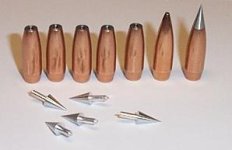B
bsl135
Guest
Law Dawg
Jim,
Thanks for sharing your process of closing meplats.
With the procedure you describe, I would be very weary of introducing a mass imbalance at the bullet tip. I'm talking about the step where you uniform the inside of the meplat. How can you be sure that you're drilling (or reaming?) the hole exactly on axis? Even using a collet and perfectly aligned tail stock, there's still the issue of cutter drift.
Obviously if that hole is drilled even slightly off center, it's bad news. Even if you can close the meplat to a needle point, if you're hole isn't perfectly centered the bullets will fly with an imbalance and not be as precise.
I completely believe that your process works for you, however, I am curious about the grouping potential of bullets treated as you describe. Have you shot groups of stock bullets and treated bullets to compare group size?
If you are able to do this and still shoot good groups, then I think that's quite an accomplishment. However, I would stop short of saying it's 'easy'. Not everyone has a mini-lathe and personal connections with Mr. Pindell
Take care,
-Bryan
Jim,
Thanks for sharing your process of closing meplats.
With the procedure you describe, I would be very weary of introducing a mass imbalance at the bullet tip. I'm talking about the step where you uniform the inside of the meplat. How can you be sure that you're drilling (or reaming?) the hole exactly on axis? Even using a collet and perfectly aligned tail stock, there's still the issue of cutter drift.
Obviously if that hole is drilled even slightly off center, it's bad news. Even if you can close the meplat to a needle point, if you're hole isn't perfectly centered the bullets will fly with an imbalance and not be as precise.
I completely believe that your process works for you, however, I am curious about the grouping potential of bullets treated as you describe. Have you shot groups of stock bullets and treated bullets to compare group size?
If you are able to do this and still shoot good groups, then I think that's quite an accomplishment. However, I would stop short of saying it's 'easy'. Not everyone has a mini-lathe and personal connections with Mr. Pindell
Take care,
-Bryan


